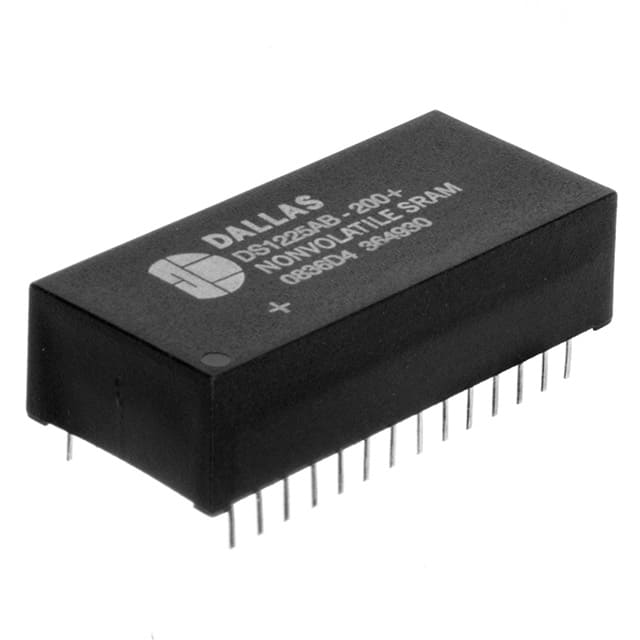Lihat spesifikasi untuk detail produk.

DS1230AB-200IND
Product Overview
Category
The DS1230AB-200IND belongs to the category of non-volatile static random-access memory (NVSRAM).
Use
This product is commonly used as a storage device in various electronic systems where data retention even during power loss is crucial.
Characteristics
- Non-volatile: The DS1230AB-200IND retains data even when power is disconnected.
- Static RAM: It provides fast read and write access times.
- High density: The DS1230AB-200IND offers a large storage capacity.
- Low power consumption: It operates efficiently, consuming minimal power.
- Durable: This product has a long lifespan and can withstand harsh environmental conditions.
Package
The DS1230AB-200IND is available in a standard 32-pin DIP (Dual Inline Package) format.
Essence
The essence of the DS1230AB-200IND lies in its ability to combine the benefits of both volatile and non-volatile memories. It offers the speed and ease of use of static RAM while ensuring data persistence like non-volatile memory.
Packaging/Quantity
The DS1230AB-200IND is typically packaged individually and is available in various quantities depending on the manufacturer's specifications.
Specifications
- Memory Capacity: 2 Megabits (256K x 8)
- Access Time: 200 nanoseconds
- Supply Voltage: 4.5V to 5.5V
- Operating Temperature Range: -40°C to +85°C
- Data Retention: Minimum 10 years
Detailed Pin Configuration
The DS1230AB-200IND features a 32-pin DIP package with the following pin configuration:
- Chip Enable (CE)
- Output Enable (OE)
- Write Enable (WE)
- Address Inputs (A0-A17)
- Data Inputs/Outputs (DQ0-DQ7)
- Ground (GND)
- No Connection (NC)
- Supply Voltage (VCC)
Functional Features
- Battery Backup: The DS1230AB-200IND includes an integrated lithium energy source, ensuring data retention during power loss.
- Automatic Store on Power Loss: It automatically transfers data from the volatile RAM to non-volatile memory when power is disconnected.
- High-Speed Access: The DS1230AB-200IND provides fast read and write access times, making it suitable for real-time applications.
Advantages and Disadvantages
Advantages
- Non-volatile data storage
- Fast access times
- High-density storage capacity
- Low power consumption
- Durable and reliable
Disadvantages
- Relatively higher cost compared to traditional RAM
- Limited write endurance compared to other non-volatile memories
Working Principles
The DS1230AB-200IND combines a static RAM array with a non-volatile EEPROM (Electrically Erasable Programmable Read-Only Memory) element. When power is available, the device operates as a standard static RAM. However, in the event of a power loss, the integrated lithium energy source ensures that the data is transferred from the volatile RAM to the non-volatile EEPROM, preserving the information.
Detailed Application Field Plans
The DS1230AB-200IND finds applications in various fields, including:
- Industrial Control Systems: Used for storing critical system parameters and configuration data.
- Medical Devices: Utilized for data logging and storing patient information.
- Automotive Electronics: Employed in vehicle control units for storing calibration data and fault codes.
- Aerospace Systems: Used for mission-critical data storage in satellites and spacecraft.
- Communication Equipment: Utilized for storing network settings and firmware updates.
Detailed and Complete Alternative Models
- DS1230AB-100IND: Similar to DS1230AB-200IND but with a 100 nanosecond access time.
- DS1230AB-150IND: Similar to DS1230AB-200IND but with a 150 nanosecond access time.
- DS1230AB-250IND: Similar to DS1230AB-200IND but with a 250 nanosecond access time.
These alternative models offer different access times to suit specific application requirements while maintaining similar functionality and characteristics.
Word count: 533 words
Sebutkan 10 pertanyaan dan jawaban umum terkait penerapan DS1230AB-200IND dalam solusi teknis
Sure! Here are 10 common questions and answers related to the application of DS1230AB-200IND in technical solutions:
Q: What is DS1230AB-200IND? A: DS1230AB-200IND is a non-volatile static RAM (NVSRAM) integrated circuit that combines the benefits of both SRAM and EEPROM technologies.
Q: What are the key features of DS1230AB-200IND? A: The key features include a 32K (4K x 8) non-volatile memory, battery backup, unlimited write cycles, and fast access times.
Q: How is DS1230AB-200IND powered? A: DS1230AB-200IND can be powered by an external battery or a supercapacitor for backup power during power loss.
Q: What is the purpose of using DS1230AB-200IND in technical solutions? A: DS1230AB-200IND is commonly used in applications where data needs to be retained even during power outages or system shutdowns.
Q: Can DS1230AB-200IND be used as a replacement for regular SRAM? A: Yes, DS1230AB-200IND can be used as a drop-in replacement for regular SRAM, providing non-volatile storage capability.
Q: How fast is the access time of DS1230AB-200IND? A: DS1230AB-200IND has a fast access time of 200 nanoseconds, making it suitable for high-speed applications.
Q: Is DS1230AB-200IND compatible with standard microcontrollers or processors? A: Yes, DS1230AB-200IND is compatible with most standard microcontrollers and processors that support SRAM interfaces.
Q: Can DS1230AB-200IND be used in industrial environments? A: Yes, DS1230AB-200IND is designed to operate in a wide temperature range and can be used in industrial applications.
Q: How reliable is DS1230AB-200IND for long-term data storage? A: DS1230AB-200IND has a minimum data retention period of 10 years and offers high reliability for long-term data storage.
Q: Are there any limitations or considerations when using DS1230AB-200IND? A: Some considerations include the need for an external battery or supercapacitor, limited memory capacity (32K), and the requirement for proper backup power management.

